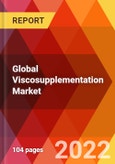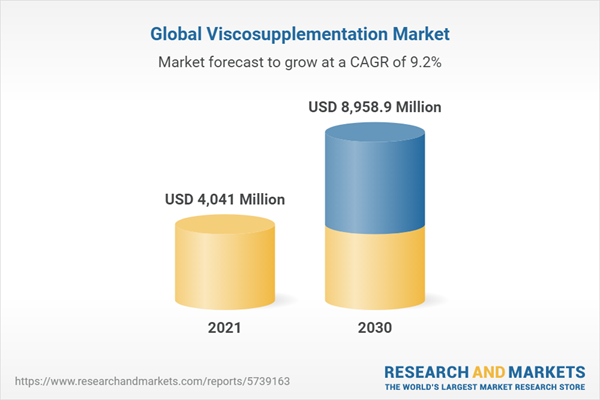The global viscosupplementation market held a market value of USD 4,041 million in 2021 and is projected to reach USD 8,958.9 million by the year 2030. The market is projected to list a CAGR of 9.2% during the forecast period.Global Viscosupplementation Market is projected to grow at a CAGR of 9.2% during the forecast period 2022-2030
Some of the reasons anticipated to propel the market include the rising need for non-surgical treatments for osteoarthritis, the prevalence of illnesses brought on by a sedentary lifestyle, and improvements in the creation of hyaluronic acid-based therapies. The market-available viscosupplements have been clinically demonstrated to be the most efficient treatment for knee osteoarthritis. Osteoarthritis is the most common chronic cause of disability and is a painful degenerative joint condition. The condition typically begins after the age of 30, and after 10 years of diagnosis, it may grow to become a disability.
Growth Influencers:
Surging geriatric populations and prevalence of Osteoarthritis will drive the growth of the marketThe rising geriatric population is driving the market growth. According to projections made by the WHO, the number of people 65 and older in the world is expected to climb from 7% in 2000 to 16% in 2050, which will subsequently cause an increase in the prevalence of obesity and osteoarthritis. Thus, it is anticipated that over the projection period, the demand for the product would develop significantly due to the global expansion in the target population and the growing preference for alternate treatment alternatives for corticosteroids for the management of joint pain.
Combination Therapy of Gel Injection and Knee Bracing Benefit Moderate-grade Knee Arthritis Patients
Hyaluronic acid is the active component in knee arthritis gel injections. Our bodies naturally manufacture hyaluronic acid. It is an essential part of the synovial fluid that lubricates many of our joints. Over time, the quality of hyaluronic acid in knees with osteoarthritis declines. Synovial fluid's consistency is affected by low-quality hyaluronic acid, which lessens the fluid's capacity for lubrication and shock absorption. Greater lubrication is the main advantage of hyaluronic acid injections into joints. There are, however, a number of additional ways in which it might enhance joint performance. An antioxidant, hyaluronic acid, has the ability to prevent the buildup of dangerous compounds in the knee joint. The capacity of the knee joint to repair cartilage may be enhanced by hyaluronic acid. Hyaluronic acid may lessen joint inflammation, easing arthritis-related stiffness and pain.
Healthcare Infrastructure growth Installed base and rise in demand for the treatment procedures.
In the U.K. and France, osteoporosis affects more than 2.5 million women annually. Following a decision by the Haute Autorité de Santé (HAS), the Caisse Primaire d'Assurance Maladie will pay 70% of the cost of the scan (CPAM). Additionally, the Caisse Primaire d'Assurance Maladie has been advised to reimburse BONVIVA, a medication used to strengthen bones and given in the U.K., at a rate of 65%, according to Haute Autorité de Santé (HAS), the health authority (CPAM). The market is being driven by increasing consumer preference for quick turnaround times even if they are expensive and rising rates of target diseases like osteoarthritis.
Segments Overview:
The global viscosupplementation market is segmented into product type, application, material type, packaging type, and end user.By Product Type
- Single Injection
- Three Injection
- Five Injection
By End User
- Hospitals
- Orthopedic Clinics/ASCs
Regional Overview
The global viscosupplementation market is expected to grow expansively during the forecast period due to the rising strategic expansions by the companies functioning in the industry. The market based on region, is segmented into North America, Europe, Asia Pacific, Middle East and Africa, and South America. The Asia Pacific market for viscosupplementation held the largest market share of more than 50% in 2020, with a revenue of USD 1,440.9 million. The regional market is also projected to hold the fastest CAGR of more than 4.8% during the anticipated period.Competitive Landscape
The prominent players operating in the global viscosupplementation market include Sanofi, Anika Therapeutics, Inc., Seikagaku Corporation, Zimmer Biomet, SMITH & NEPHEW PLC, LG Chem, Lifecore, Ferring B.V., Fidia Farmaceutici S.p.A.,and others. The major nine players in the market hold approximately 50% of the total market share. These market players are investing in joint ventures, product launches, mergers, expansions. For instance, Hyalofast, a hyaluronic acid-based scaffold for cartilage repair, was introduced by Anika Therapeutics, Inc. in June 2019 at the International Cartilage Regeneration and Joint Preservation Society (ICRS).The global viscosupplementation market report provides insights on the below pointers:
- Market Penetration: Provides comprehensive information on the market offered by the prominent players
- Market Development: The report offers detailed information about lucrative emerging markets and analyzes penetration across mature segments of the markets
- Market Diversification: Provides in-depth information about recent developments, and investments
- Competitive Landscape Assessment: Mergers & acquisitions, certifications, product launches in the global viscosupplementation market have been provided in this research report In addition, the report also emphasizes the SWOT analysis of the leading players
- Product Development & Innovation: The report provides intelligent insights on future technologies, R&D activities, and breakthrough product developments
- Pricing Analysis: Pricing analysis of various components used in the manufacturing of viscosupplementation
- Manufacturing Cost Analysis: Cost-share of various components in medical supply products, cost analysis, unit cost analysis
The global viscosupplementation market report answers questions such as:
- What is the market size and forecast of the global viscosupplementation market?
- What are the inhibiting factors and impact of covid-19 on the global viscosupplementation market during the assessment period?
- Which are the types/segments/applications/areas to invest in over the assessment period in the global viscosupplementation market?
- What is the competitive strategic window for opportunities in the global viscosupplementation market?
- What are the technology trends and regulatory frameworks in the global viscosupplementation market?
- What is the market share of the leading players in the global viscosupplementation market?
- What modes and strategic moves are considered favorable for entering the global viscosupplementation market?
Table of Contents
Chapter 1 Viscosupplementation Market Scope1.1 Product Overview and Scope of Viscosupplementation
1.2 Market Taxonomy
1.3 Objective of the study
Chapter 2 Research Methodology
2.1 Research Process
2.2 Primary Research
2.3 Secondary Research
2.4 Data Collection Technique
2.5 Data Sources
2.6 Secondary Sources
2.7 Primary Sources
2.8 Market Estimation Methodology
2.9 Market Size Estimation Methodology
2.10 Forecasting Methodology
2.11 Limitations
Chapter 3 Executive Summary
3.1.1 Market Introduction
3.1.2 Market Value and Growth Factor Analysis
3.1.3 Segmental Overview
Chapter 4 Market Overview
4.1 Parent Market
4.1.1 Global hyaluronic acid market
4.2 Ancillary Market
4.2.1 Global knee replacement/implants market
4.3 Penetration & Growth Prospect Mapping
4.4 Market Dynamics
4.4.1 Drivers
4.4.1.1 Surging geriatric populations and prevalence of Osteoarthritis will drive the growth of the market
4.4.1.2 Combination Therapy of Gel Injection and Knee Bracing Benefit Moderate-grade Knee Arthritis Patients
4.4.1.3 Healthcare Infrastructure growth Installed base and rise in demand for the treatment procedures
4.4.2 Restraints
4.4.2.1 High Cost and Adverse Effect Hamper the Market Growth
4.5 Clinical Trials
4.6 Porter’s 5 Force Model
4.6.1 Competitive Rivalry (High)
4.6.2 Threat of Substitute (Moderate)
4.6.3 Threat of New Entrant (Moderate)
4.6.4 Bargaining Power of Buyers (High)
4.6.5 Bargaining Power of Suppliers (Moderate)
4.7 SWOT Analysis
4.7.1 Strength
4.7.2 Weakness
4.7.3 Opportunity
4.7.4 Threat
4.8 Major Deals & Strategic Alliances Analysis
4.9 Product Pricing Analysis
4.9.1 Product Type and Brand
4.10 Distribution Channel Analysis
4.10.1 Distribution and Marketing Rights of Viscosupplements
4.10.2 NORTH AMERICA
4.10.3 EUROPE
4.10.4 ASIA PACIFIC
4.10.5 LATIN AMERICA
4.10.6 MIDDLE EAST & AFRICA
4.11 COVID-19 Impact
4.11.1 COVID-19 Status Overview
4.11.2 Influence of COVID-19 Outbreak on viscosupplement Industry
Chapter 5 Global Viscosupplementation Market Analysis, by Region
5.1 Sector Breakdown Assessment, 2017-2030
5.1.1 Global Viscosupplementation Market Revenue by Region (2017-2030)
Chapter 6 Global Viscosupplementation Market Analysis, by Product Type
6.1 Introduction
Chapter 7 Global Viscosupplementation Market Analysis, by End Users
7.1 Introduction
Chapter 8 North America Viscosupplementation Market Analysis
8.1 Introduction
8.1.1 North America Viscosupplementation Market Revenue by Country (2017-2030)
8.1.2 North America Viscosupplementation Market Revenue by Product Type (2017-2030)
8.1.3 North America Viscosupplementation Market Revenue by End Users (2017-2030)
Chapter 9 Europe Viscosupplementation Market Analysis
9.1 Introduction
9.1.1 Europe Viscosupplementation Market Revenue and by Country (2017-2030)
9.1.2 Europe Viscosupplementation Market Revenue and by Product Type (2017-2030)
9.1.3 Europe Viscosupplementation Market Revenue and by End Users (2017-2030)
Chapter 10 Asia Pacific Viscosupplementation Market Analysis
10.1 Introduction
10.1.1 APAC Viscosupplementation Market Revenue and by Country (2017-2030)
10.1.2 APAC Viscosupplementation Market Revenue and by Product Type (2017-2030)
10.1.3 APAC Viscosupplementation Market Revenue and by End Users (2017-2030)
Chapter 11 Latin America Viscosupplementation Market Analysis
11.1 Introduction
11.1.1 South America Viscosupplementation Market Revenue and by Country (2017-2030)
11.1.2 South America Viscosupplementation Market Revenue and by Product Type (2017-2030)
Chapter 12 MEA Viscosupplementation Market Analysis
12.1 Introduction
12.1.1 MEA Viscosupplementation Market Revenue and by Country (2017-2030)
12.1.2 MEA Viscosupplementation Market Revenue and by Product Type (2017-2030)
12.1.3 MEA Viscosupplementation Market Revenue and by End Users (2017-2030)
Chapter 13 REIMBURSEMENT OUTLOOK
13.1 Direct Medical Cost of Treatment of Osteoarthritis
13.2 Reimbursement by Product
13.2.1 Gel-one
13.2.2 Euflexxa
13.2.3 Synvisc-one
13.2.4 Supartz
13.2.5 Hyalgan
13.2.6 Monovisc
13.2.7 Orthovisc
Chapter 14 COMPETITIVE LANDSCAPE
14.1 Participant Categorization
14.2 Recent Developments & Impact Analysis, by Key Market Participants
14.3 Company Categorization
14.4 Company Market Positioning Analysis
Chapter 15 Company Profiles
15.1 Sanofi
15.1.1 Company Information
15.1.2 Main Business Overview
15.1.3 Products Offered
15.1.4 Company Financials
15.2 ANIKA THERAPEUTICS, INC.
15.2.1 Company Information
15.2.2 Main Business Overview
15.2.3 Products Offered
15.2.4 Company Financials
15.3 SEIKAGAKU CORPORATION
15.3.1 Company Information
15.3.2 Main Business Overview
15.3.3 Products Offered
15.3.4 Company Financials
15.4 Zimmer Biomet
15.4.1 Company Information
15.4.2 Main Business Overview
15.4.3 Products Offered
15.4.4 Company Financials
15.5 SMITH & NEPHEW PLC
15.5.1 Company Information
15.5.2 Main Business Overview
15.5.3 Products Offered
15.5.4 Company Financials
15.6 LG Chem
15.6.1 Company Information
15.6.2 Main Business Overview
15.6.3 Products Offered
15.6.4 Company Financials
15.7 LIFECORE
15.7.1 Company Information
15.7.2 Main Business Overview
15.7.3 Products Offered
15.7.4 Company Financials
15.8 Ferring B.V.
15.8.1 Company Information
15.8.2 Main Business Overview
15.8.3 Products Offered
15.8.4 Company Financials
15.9 Fidia Farmaceutici S.p.A.
15.9.1 Company Information
15.9.2 Main Business Overview
15.9.3 Products Offered
15.9.4 Company Financials
Executive Summary
The global viscosupplementation market is projected to grow at a steady rate owing to the increased incidence and prevalence rates of osteoarthritis and other bone related diseases. The increasing approvals and product launches, especially in the field of combination therapy of gel injection and knee bracing play a prominent role in bolstering the market growth. However, the high cost of the product decreases the preference rates. The industry is anticipated to reach USD 8,958.9 million by 2030. In addition to that, the prominent market players are involved in strategic activities, such as product launches, and mergers. The market is segmented based on product type and end user.Companies Mentioned (Partial List)
A selection of companies mentioned in this report includes, but is not limited to:
- Sanofi
- Anika Therapeutics, Inc.
- Seikagaku Corporation
- Zimmer Biomet
- SMITH & NEPHEW PLC
- LG Chem
- Lifecore
- Ferring B.V.
- Fidia Farmaceutici S.p.A
Table Information
| Report Attribute | Details |
|---|---|
| No. of Pages | 104 |
| Published | December 2022 |
| Forecast Period | 2021 - 2030 |
| Estimated Market Value ( USD | $ 4041 Million |
| Forecasted Market Value ( USD | $ 8958.9 Million |
| Compound Annual Growth Rate | 9.2% |
| Regions Covered | Global |









